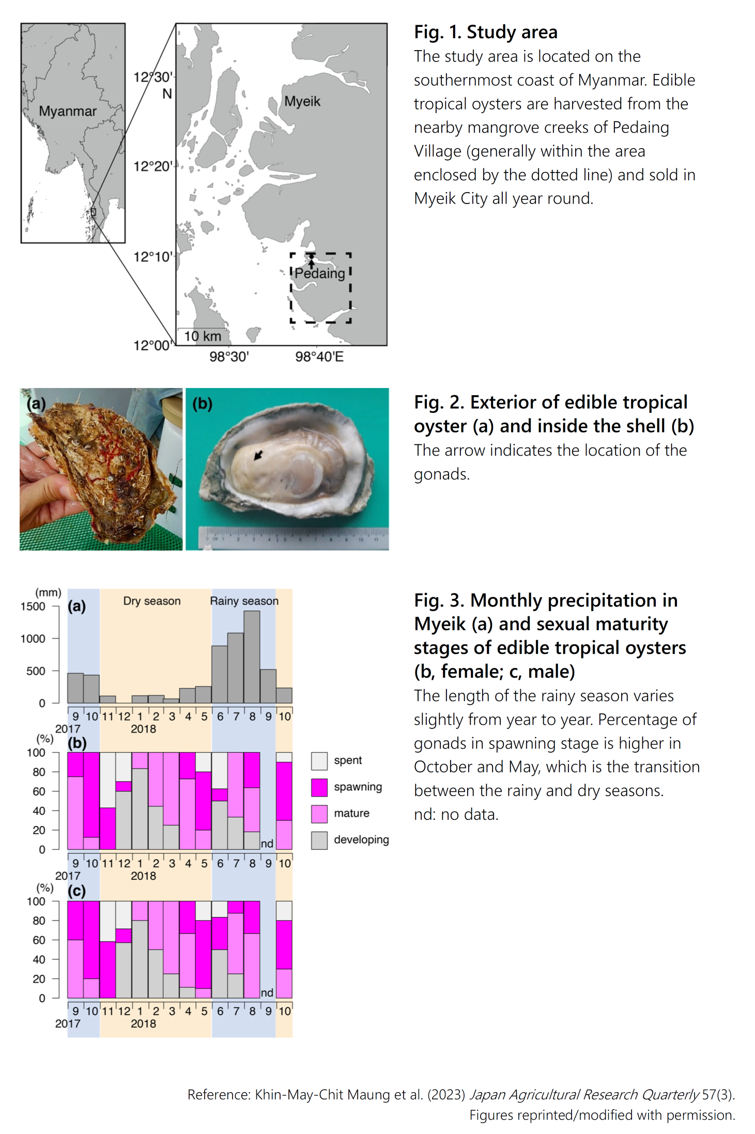Spawning season of the edible tropical oyster Crassostrea belcheri in the coastal area of Myeik, southern Myanmar
Description
Oyster aquaculture research in Myanmar started in the 1970s, but commercial oyster farming techniques have not yet been established. The availability of seed oysters for oyster farming depends on the natural occurrence of juvenile oysters in coastal areas in the case of natural seedling collection. Therefore, the relationship between the environment of the target area and the spawning period of the target species needs to be clarified. In temperate regions, where water temperatures vary greatly between winter and summer, many species spawn once a year in the summer when water temperatures rise, whereas in tropical regions, where water temperatures are high all year round, they often spawn year-round. However, there is seasonal variation in the proportion of spawning individuals. The main spawning seasons have been reported as once, twice, or three times a year, and the timing may vary from region to region, even for the same species. This study aims to reveal the reproductive cycle of the edible tropical oyster (Crassostrea belcheri) from the waters near Myeik (Fig. 1) in southern Myanmar and to identify suitable periods for natural seedling collection of the species. From September 2017 to October 2018, 12–20 edible tropical oysters were obtained monthly from markets in Myeik (Fig. 2). Gonadal tissue sections were examined under an optical microscope, and maturity stages were determined.
The local climate is a tropical monsoon climate with a distinct dry and rainy season, with significantly higher rainfall in the rainy season. During the study period, monthly rainfall exceeded 400 mm in September–October 2017 and June–September 2018 (Fig. 3a). Histological analysis of C. belcheri gonads revealed that spawning occurred throughout the study period except January–March 2018, peaking at the beginning and end of the dry season in October–November and April–May, respectively (Fig. 3b, c).
The installation of collectors in the sea during the transition from dry to rainy season or from rainy to dry season is expected to increase the efficiency of natural seedling collection. Local meteorological information makes it possible to estimate the spawning season of edible tropical oysters, thus the timing of the placement of seedling collectors in the sea. However, during the rainy season, the survival and growth of juvenile oysters recruited before the rainy season would be hampered by low salinity due to freshwater inflow, etc. Further research is needed on survival and growth rates after the spawning season to establish efficient natural seedling collection techniques.
Figure, table
- Research project
- Program name
- Term of research
-
FY2017–2022
- Responsible researcher
-
Toyokawa Masaya ( Fisheries Division )
KAKEN Researcher No.: 60371837Yurimoto Tatsuya ( Fisheries Division )
Khin-May-Chit-Maung ( Marine Science Department, Myeik University )
Saito Hajime ( Fisheries Division )
- ほか
- Publication, etc.
-
Khin-May-Chit-Maung et al. (2023) JARQ in press
- Japanese PDF
-
2022_B06_ja.pdf1.07 MB
- English PDF
-
2022_B06_en.pdf590.54 KB
* Affiliation at the time of implementation of the study.

